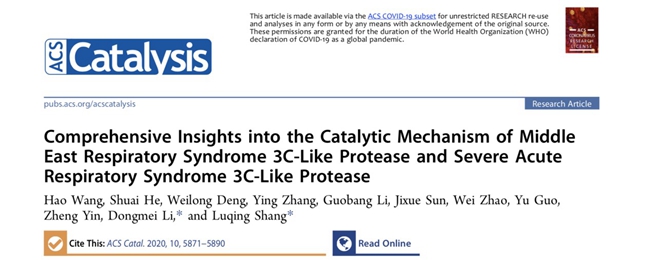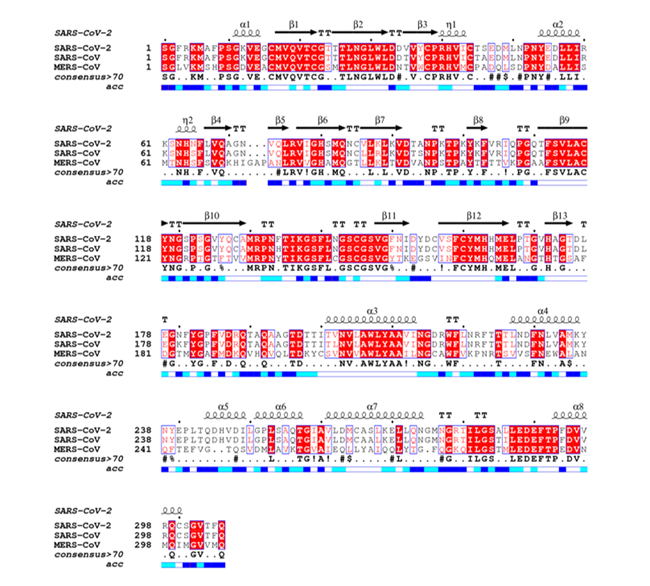Nankai Research Team Revealed the Catalytic Mechanism of the Main Proteases of MERS-CoV and SARS-CoV

Within the past few days, the research team of Associate Professor Shang Luqing of the state key laboratory of chemical biology in the College of Pharmacology of Nankai University has proclaimed the discovery of the catalytic mechanism of the main protease of coronavirus. The difference between the main proteases of coronavirus MERS-CoV and SARS-CoV was discussed, and the bioactivity of the main protease inhibitor was further optimized. This work lays a foundation for future research on coping with coronavirus variation, and aims to facilitate the R&D of novel coronavirus. The paper describing the results was published in ACS Catalysis, a journal of the American Chemical Society.
COVID-19 is an RNA virus that resembles a corona and has the largest genome of any known RNA virus. Since 1965, when human-pathogenic coronaviruses were first isolated, seven types of coronaviruses have been found to cause human disease. Among them, four types can lead to human mild respiratory disease; they are HCoV-229E, HCoV-NL63, HCoV-HKU1 and Hcov-oc43. They account for 10% to 30% of clinical respiratory tract infections. The other three types, SARS-CoV, MERS-CoV and SARS-CoV-2(novel coronaviruses) , are highly pathogenic coronaviruses, the lethal rates of which are as high as 10%-30%. In particular, COVID-19 caused by novel coronavirus, so far has caused the infection of up to 5 million people and more than 300,000 deaths, with an extremely rapid rate of global spread.
There is no clinically specific drug to treat COVID-19, so it is of vital significance to study the general mechanism of the key proteins of antiviral drugs. In the life activity of coronavirus, its main protease (3c-like protease) can effectively cut off the protein precursors of the virus, and then produce the functional proteins of the virus, which is very important for the replication of coronavirus and other life activity. Therefore, the main protease is an important target in the research of anti-coronavirus drugs.
At present, the research on this type of protease mainly focuses on the specificity of its substrate and dimerization, but the lack of systematic study on its catalytic mechanism restricts the development of corresponding antiviral drugs. Therefore, revealing the catalytic mechanism of the main protease of coronaviruses allows better design and discovery of main protease inhibitors, thereby accelerating antiviral drug development. Said Shang Luqing.

Study on the Catalytic Mechanism of Coronavirus Protease
With the goal of obtaining the crystal structures of MERS-CoV and SARS-CoV main proteases, Shang Luqing's group constructed an enzyme activity analysis system to determine the catalytic activity center of proteases, and then carried out the corresponding main study. The team studied the catalytic mechanism of the recognition stage and digestion stage of MERS-CoV and SARS-CoV with methods of structural biology, protein mutation, enzymatic reaction kinetics, molecular dynamics simulation, and quantitative calculation combined. In the recognition stage, the team proclaimed why the S1 pocket of the protease recognizes Gln with a highly conserved substrate; in the catalytic stage, the team studied how the substrate is immobilized by the protease on the one hand and elucidated the presence of an important negative center in the protease on the other hand. To better understand the individual characteristics of these two proteases, the team used small molecule inhibitor probes, explored the catalytic differences between MERS-CoV and SARS-CoV main proteases, with structural biology, enzymology and other methods combined.
Based on the above studies on the catalytic mechanism, Shang Luqing's team optimized the structure of protease inhibitors, effectively improving the activity of inhibitors, which lays a solid foundation for the further study of antiviral drugs. They also managed to find potential allosteric inhibition sites, providing a new idea for the R&D of antiviral drugs targeting proteases.

Study on the Differentiation of MERS-CoV and SARS-CoV Major Protease Catalysts
In response to the rampage of COVID-19 outbreak, the team also performed sequence comparison and molecular overlap between the main protease of novel coronavirus and the previously reported protease of the coronavirus and found that the studied sites were conserved in the main protease of the novel coronavirus and several known coronaviruses. “This suggests that the mechanism revealed by our study may be a universal mechanism for the main protease of coronaviruses, which is important for the development of broad-spectrum antiviral drugs in response to coronaviruses that are currently rampant and emerging in the future. Shang Luqing said.

Sequence Alignment of SARS-CoV-2, SARS-CoV, MERS-CoV Main Protease
Wang Hao, doctoral candidate of the College of Pharmacology, Nankai University serves as the first author of the paper; associate professor Shang Luqing , and associate professor Li Dongmei are listed as co-authors. This research work was supported by the National Key R & D Program, the National Natural Science Foundation of China and the Tianjin Natural Science Foundation of China.
Link of the paper: https://pubs.acs.org/doi/10.1021/acscatal.0c00110
( Reported by Junhui Wu, Translated by Zheng Guangyu, Edited by Daniel Stefan and JianjingYun)









